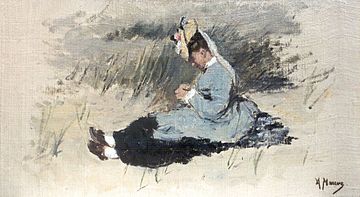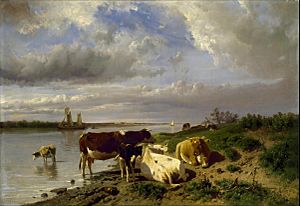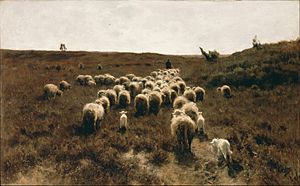Anton Mauve facts for kids
Quick facts for kids
Anton Mauve
|
|
|---|---|
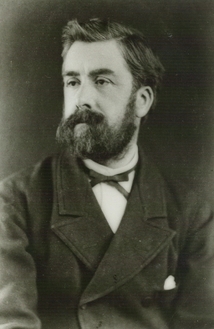 |
|
| Born | 18 September 1838 Zaandam, Netherlands
|
| Died | 5 February 1888 (aged 49) Arnhem, Netherlands
|
| Nationality | Dutch |
| Known for | Painting |
| Movement | Realism |
| Patron(s) | Goupil & Cie |
Anthonij "Anton" Rudolf Mauve (born September 18, 1838 – died February 5, 1888) was a famous Dutch painter. He was known for his realistic paintings and was a key member of the Hague School of artists. He often signed his artworks 'A. Mauve' or used his initials 'A.M.'.
Anton Mauve was a master of using colors. He had a big impact on his cousin-in-law, the well-known painter Vincent van Gogh. Mauve's most famous paintings often show peasants working in fields. His paintings of sheep flocks were especially popular, especially in America!
Life and Work of Anton Mauve
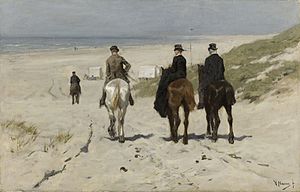
Anton Mauve was born on September 18, 1838, in Zaandam, a town in the Netherlands. When he was one year old, his father, who was a Mennonite chaplain, moved the family to Haarlem. This is where Anton grew up.
He learned to paint by training with other artists like Pieter Frederik van Os and Wouter Verschuur. Later, he worked with Paul Gabriël. They often painted outdoors, directly from nature, in a place called Oosterbeek. This area was known as the 'Dutch Barbizon' because it was a popular spot for artists.
Mauve was friends with famous painters like Jozef Israëls and Willem Maris. Their work inspired him to change his painting style. He moved from very detailed paintings to a freer, looser way of painting. He also started using softer colors, like gentle greys, greens, and light blues.
Most of Mauve's art shows people and animals in outdoor scenes. For example, his painting Morning Ride in the Rijksmuseum shows people riding horses by the sea. This painting shows his dedication to making his art look very real.
In 1872, Mauve moved to The Hague. There, he became an important artist in the Hague School. He also helped start the Hollandsche Teekenmaatschappij art society in 1876. He played a big part in the Pulchri Studio, which was a very important art group in The Hague. In 1874, he married Ariëtte (Jet) Carbentus. They had a son named Anton, who also became a painter.
In his last two years, Mauve lived in the village of Laren. This area was part of the Gooi region. Other painters, like Jozef Israëls, also settled there. This group of artists became known as the Larense School. The Gooi region was even called 'Mauve land' in places as far away as the United States! Anton Mauve passed away suddenly in Arnhem on February 5, 1888.
Anton Mauve and Vincent van Gogh
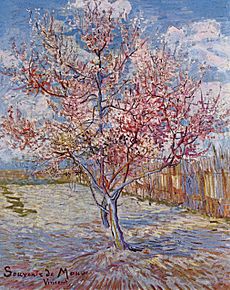
Anton Mauve was married to Ariëtte (Jet) Sophia Jeannette Carbentus, who was a cousin of Vincent van Gogh. Mauve had a huge influence on Van Gogh, who looked up to him a lot. Van Gogh mentioned Mauve many times in his letters, showing how important he was to him.
Van Gogh spent three weeks at Mauve's art studio in late 1881. During this time, Mauve taught him how to paint. Van Gogh first tried oil painting and then watercolors. Mauve encouraged him and even lent him money to rent his own studio. However, their relationship later became difficult.
In a letter to his brother Theo, Van Gogh wrote about a "very regrettable conversation" with Mauve. Mauve told him that their connection was "over and done with." Even though they had a disagreement, Van Gogh continued to respect Mauve greatly. After Mauve's sudden death, Van Gogh dedicated one of his most famous paintings to Mauve's memory.
Selected Works
- Entering the Fold (c. 1885–8), drawing and watercolour, Tate Gallery
- Milking Time (c. 1875), oil on canvas, National Gallery
- Landscape with cattle, chalk on paper, Courtauld Institute of Art
- Landscape with Cattle, oil on canvas, Museum of Fine Arts, Houston
- Shepherdess, oil on canvas, National Museum of Wales
- Morning Ride along the Beach (1876), oil on canvas, Rijksmuseum Amsterdam
- Riders in the Snow in the Haagse Bos (1879), watercolour and gouache, Rijksmuseum Amsterdam
- De Torenlaan te Laren (1886), oil on canvas, Rijksmuseum, Amsterdam
- Ariëtte Carbentus, wife of the artist, sitting in the dunes (c. 1876), oil on canvas, Rijksbureau voor Kunsthistorische Documentatie, The Hague (private collection)
- Gathering Seaweed, oil on canvas, Musée d'Orsay, Paris
- Changing Pasture (c. 1880s), oil on canvas, Metropolitan Museum of Art, New York
- The Return of the Flock, Laren (c. 1886 -1887), oil on canvas, Philadelphia Museum of Art, Philadelphia
- Digging up a Tree, watercolor, Museum of Fine Arts, Boston
- Returning Home, oil on wood, Art Gallery of New South Wales
- A Shepherdess and Her Flock, oil on canvas, Metropolitan Museum of Art
See Also
 In Spanish: Anton Mauve para niños
In Spanish: Anton Mauve para niños
- The Letters of Vincent van Gogh


